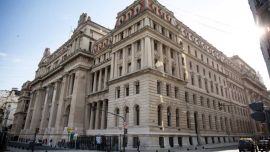The electoral roll for this year’s national elections totals 35,394,425 citizens, with Buenos Aires Province home to almost four out of every 10 voters.
The nation’s key battleground hosts 37.04 percent of the overall electorate, according to government data and, like most of the nation’s districts, has gained voters since the last time Argentina went to the ballot-box. However, the nation’s capital, Buenos Aires City has lost almost 20,000 voters in comparison with the 2021 midterms.
Data from Argentina’s National Electoral Court show the ranking of the biggest electorates to be the same as in 2021, headed by Buenos Aires Province with 13,110,768 voters and followed by Córdoba (with 3,065,088 voters or 8.66 percent of the total) and Santa Fe (2,818,280 and 7.96 percent) with Buenos Aires City (2,533,092 voters and 7.16 percent of the national electorate) in fourth place.
The other seven-digit electorates are Mendoza (1,492,379 and 4.22 percent), Tucumán (1,320,478 and 3.73 percent), Entre Ríos (1,143,459 and 3.23 percent), Salta (1,090,057 and 3.08 percent) and Chaco (1,001,813 and 2.83 percent).
The middle of the table with over half a million voters is occupied by Misiones (988,482 and 2.79 percent), Corrientes (933,876 and 2.64 percent), Santiago del Estero (812,080 and 2,29 percent), San Juan (608,535 and 1.72 percent), Río Negro (595,081 and 1.68 percent), Jujuy (590,861 and 1,67%) and Neuquén (553,748 and 1.56 percent).
The provinces with the smallest electorates are Formosa (482,602 and 1.36 percent), Chubut (474,242 and 1.34 percent), San Luis (421,370 and 1.19 percent), Catamarca (340,168 and 0.96 percent), La Rioja (304,456 and 0.86 percent), La Pampa (300,160 and 0.85 percent), Santa Cruz (265,330 and 0.75 percent) and Tierra del Fuego (148,020 and 0.42 percent).
These figures include Argentine voters resident abroad although they are only qualified to vote in the general elections.
The electorate has thus grown by over a million voters (1,063,868) as against previous national elections. In 2021 34,330,557 citizens had been eligible to vote in the midterms while in 2019 the voters totalled 32,064,323.
Less voters in City
Comparing the numbers with the last national elections in 2021, Buenos Aires City was the only district to suffer a fall in the number of registered voters.
The last midterms showed 2,552,058 people eligible to vote in the Federal Capital, representing 7.43 percent of the national electorate or 18,966 more than now.
With the current data there is a 0.74 percent fall in the number of people registered to vote next August 14.
On the contrary, those provinces with the biggest increases in the number of citizens eligible to vote were San Luis with an increase of 7.09 percent on 2021, Río Negro with 6.1 percent and Chubut with 5.82 percent.
– TIMES/NA

























Comments